The Japan Tsunami Marine Debris Summary
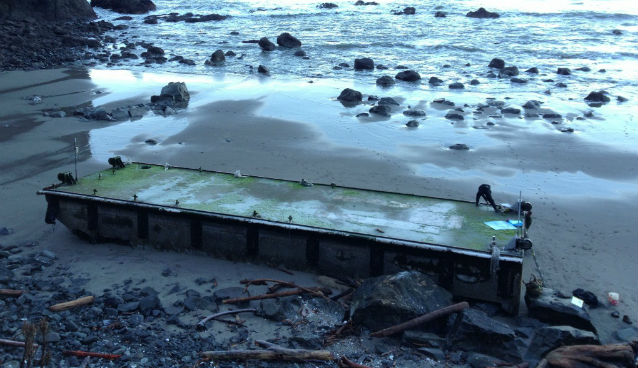
NOAA
Two years have passed since a massive earthquake and tsunami struck northeastern Japan, killing thousands and devastating coastal communities. The Government of Japan estimated that 1.5 million tons of floating debris dispersed widely over the North Pacific Ocean, carried by ocean currents and prevailing winds. Starting in the winter of 2011-2012, debris reached Alaska and West Coast states, and later Hawai’i. Federal and state agencies, tribes, NGOs, academia, and industry have been working together to address this unprecedented challenge.
Efforts to assess the problem began immediately after the event. A month after the tsunami, debris was so dispersed it could no longer be detected by satellite. Computer models estimated the movement of tsunami debris over time. A NOAA model showed that high floating debris, such as floats and foamed plastic, arrived on the West Coast, Alaska, and Hawai’i over the winter of 2011-2012 in an intermittent and widely scattered manner. Long-term forecast modeling, done by NOAA and Japan, suggests decreasing amounts of debris arriving over the next year.
To date, over 1,500 potential marine debris items have been reported through disasterdebris@noaa.gov. Japanese authorities have confirmed 21 reports as Japan tsunami marine debris (JTMD). Two floating docks, several small boats, storage boxes, soccer balls, a motorcycle, buoys, and a decorated float are among confirmed JTMD. Unconfirmed items, lacking markings to directly tie them to the tsunami event, included small boats spotted in the Pacific Ocean or found on-shore, packaging material such as foam pieces, pallets, floats, and a variety of small debris. For more information, go to: http://marinedebris.noaa.gov/tsunamidebris/
Most of the debris from the tsunami could not be readily distinguished from normal marine debris and in many cases, was handled as part of existing efforts. States provided disposal bins, cleanup supplies, and contracted cleanup crews. Some debris items like small boats have required additional efforts to remove. Two floating docks— one that beached near Newport, Oregon in June 2012 and the other in Olympic National Park in Washington in December 2012 (above)— have presented the largest individual challenge to remove and have posed significant risk of aquatic invasive species. State-specific response plans and table top exercises have been valuable tools to address these challenges.
As we enter the third year since the tsunami event, agencies have greater experience, expertise, and protocols to address any additional JTMD reaching North America and Hawaii. Modeling suggests that with the passage of time, less and less tsunami debris will wash up on our shores, and the tsunami debris blends into the existing debris that already plagues our shores.
Restoring "Plastic Beach" Back to Kamilo Point
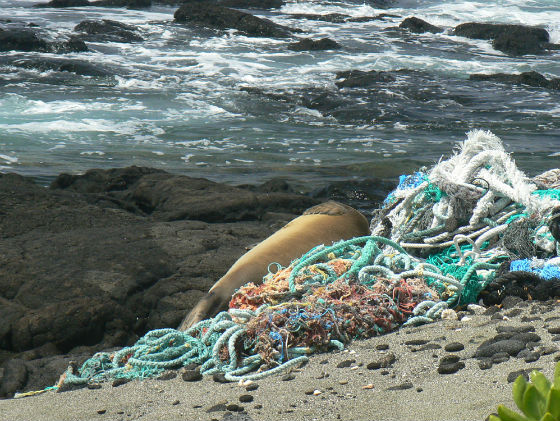
Courtesy J. Veitzbicke/NOAA
Most of the shoreline of the south coast of Hawai’i Island is rocky and rugged, well off the beaten path. Unlike much of the Main Hawaiian Islands, this coastline has not been developed. While adventuresome tourists may be found visiting the famous seacliffs at Ka Lae (South Point) or hiking out to the legendary Mahana Bay (Green Sands beach), they rarely explore the colorful tide line in the small coves and embayments below the dusty coastal trail. If they did, they would see something that is strikingly different from the otherwise natural coastal wilderness: myriad of discarded plastic.
In recent years, marine debris has been receiving more attention. Today, many people are aware that the Giant Garbage Patch is a large accumulation zone of man-made trash floating within the North Pacific (Subtropical Gyre). Here, as well as in the other oceanic gyres, marine debris amasses in densities much higher than other areas. On the southeast coast of Hawai’i Island, the small 1 km cove near Kamilo Point accumulates tons of the debris escaping the gyre. The natural combination of local currents, strong onshore winds in this region, and the low sandy beach appear to make it an ideal deposition site for floating debris. However, we humans must take the blame for the presence of this non-natural debris in the ocean.
Enter the non-profit conservation organization, Hawai’i Wildlife Fund (“HWF”). When retired marine wildlife manager turned HWF co-founder Bill Gilmartin first visited the Wai’ōhinu coastline back in 2001, he was shocked by the amount of marine debris in the region. Spending much of his career working in the Northwestern Hawaiian Islands (now Papahānaumokuākea Marine National Monument), Gilmartin was no stranger to the problems created by marine debris on wildlife. He had seen first-hand examples of fishing net entanglement of green sea turtles and Hawaiian monk seals, debris ingestion by Laysan albatross chicks and other seabirds, and direct damage to coral reefs by net bundles. In 1982, he began the marine debris collection program in the Monument. Inspired to start addressing the problem here on his home island, Gilmartin organized a large-scale beach cleanup effort in 2003 with funding from the State of Hawai’i. Over this two-day cleanup, HWF and 75 volunteers removed over 50 tons (100,000 lbs!) of marine debris from Kamilo Point.
Since that time, HWF and hundreds of volunteers have removed another 110 tons of debris from the ten-mile stretch of coastline between Kamilo and South Points with funding from NOAA’s Marine Debris Program.
Gilmartin and colleagues estimate that approximately 15 – 20 tons of debris wash ashore here annually. About every other month, HWF coordinates a community-based cleanup effort at the “dirtiest” section of this coastline. On average, they bag and remove about 3,600 lbs. of marine debris in a single day’s effort. By weight, about 62% (199,600 lbs.) of the total debris removed has been derelict fishing net bundles. Nets are generally pulled from the shoreline using a specialized winch/cable and hook setup connected to the HWF pickup. About once a year HWF ships about seven tons of these nets to O’ahu in a donated 40’ Matson® container for inclusion in NOAA’s Nets-to-Energy program where they are burned to create household electricity. The remaining 38% (120,500 lbs.) of the debris removed includes a wide variety of colors, shapes, sizes, and functions but almost all of which (>90%) are composed of plastics. Finds range from everyday items like shampoo bottles, combs and toothbrushes; fishing industry items like buoys, hagfish eel traps and glowsticks; mariculture leftovers like oyster spaces; children’s items like army toys; and a remarkable number of unidentifiable bits and pieces, broken fragments and resin pellets (aka “nurdles”). Some of the more interesting debris items include a full-size refrigerator with Japanese kanji, a military box with Soviet Union tags, and a select few glass floats made in Norway, Korea or Japan.
Over the years, most of HWF’s efforts have focused on these larger debris items. Yet, more recently they have begun focusing more on the smaller “microdebris” plastics that have infiltrated the beach sand and certain sections of rocky shoreline. Not all plastic floats (e.g., PVC pipes), but if it made its way across the North Pacific to the remote southeast coast of Hawai’i Island, chances are it does. With
this in mind, HWF has started floating the microdebris out of the denser beach sand and little by little sorting the beach and removing the man-made component.
Using this same technique, HWF volunteer and University of Hawai’i – Hilo graduate student, Catherine Spina, is currently working with advisor, Dr. Hank Carson, on a project to assess the weekly plastic debris accumulation rate for Kamilo. Carson and others at the University of Hawai’i and HWF collaborated in an investigation that links local sources of litter to marine debris accumulation around the state (Carson et al., 2013). Collaborations like these turn this “band-aid” solution into an effective learning tool and partial remedy, in which everyone can participate.
Lessons can be learned from HWF’s experience, and have been. Volunteers now see the relationship between beach litter and our own daily reliance on single-use, throw-away plastics. Worldwide, if every beach cleanup volunteer made a commitment to reduce the amount of single-use plastics they personally consume and dispose of on a daily basis, this would make a difference to the marine ecosystem. Regardless, the message behind this movement is clear: small individual steps coupled with research and strong community, private and government partnerships are moving us toward rethinking our dependence on throw-away plastics. Do your part to mālama (take care of/protect) the shoreline: Reduce, reuse, and recycle. You can also help clean up the coastal environment by participating in a local beach cleanup event, or even perhaps coordinate your own.
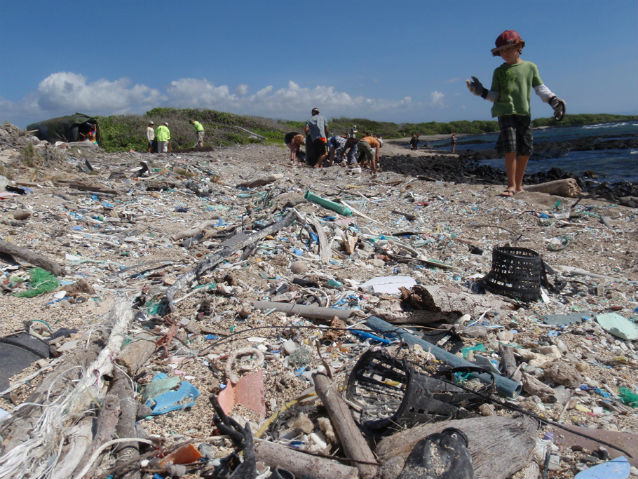
Courtesy G. Fyvie/HWF
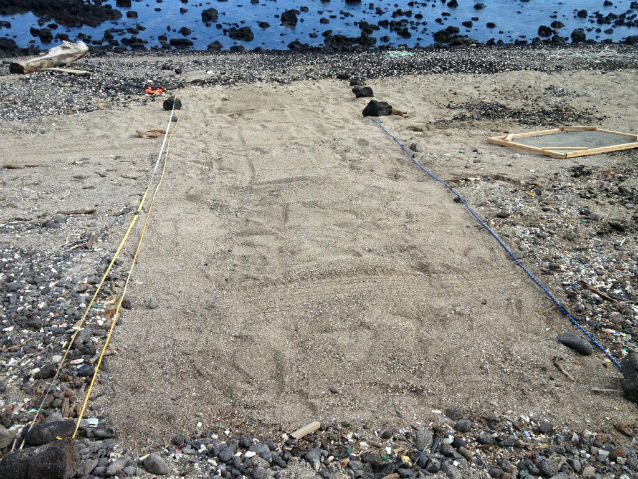
Courtesy C. Spina/University of Hawaii, Hilo
Coming to a Beach Near You
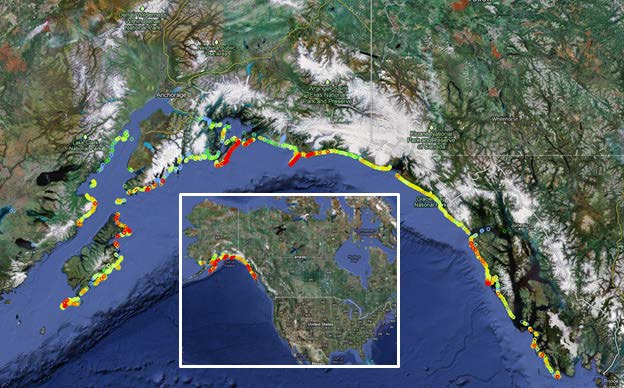
NPS
Alaska’s harsh winters limit safe field response opportunities to address marine debris along the Gulf of Alaska coast. Compounding the limited safe field operating season issue are the vast distances and associated logistics required to respond to coastal impacts. With thousands of miles of coastline potentially impacted by incoming tsunami debris, federal, state, and local officials are developing a plan to prioritize areas of debris response and clean-up in the summer of 2013. In January, response officials met to begin the prioritization process for addressing debris along Alaskan coasts that includes considerations for debris density, economic, social, environmental, cultural, and biological impacts. The National Park Service has identified Park areas for debris clean-up, surveys, and ongoing monitoring during the summer of 2013 in six coastal Alaskan national parks: Lake Clark, Katmai, Aniakchak, Kenai Fjords, Wrangell-St. Elias, and Glacier Bay.
The map shows marine debris density along the Alaska coast. Red indicates high debris density, blue indicates no debris. Surveys flown and analyzed by Airborne Technologies Inc. in 2012. Data available from the Environmental Response Management Application, ERMA Arctic.
An Unexpected Visitor
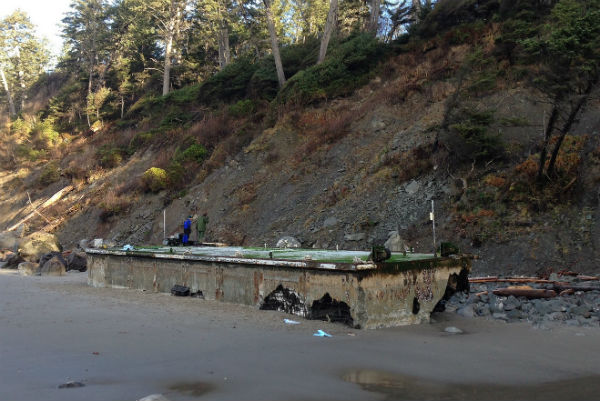
Courtesy Washington State Department of Fish and Wildlife
A hike along the wilderness coast of Olympic National Park offers visitors unparalleled views and opportunities for adventure. Waves crash against towering sea stacks, tide pools host a rainbow of intertidal life, and an occasional otter or whale may surface just off shore. Along this remote and rugged stretch of Pacific coastline, there are few human traces, and trails offer the only access to most beaches. But on December 17, 2012, the landscape at one of these remote beaches changed dramatically when a 188-ton dock set adrift from Misawa, Japan by the March 2011 tsunami washed ashore during winter high tides.
As the dock floated towards shore, it was buffeted by high surf and scraped against rocky outcrops, shedding pieces of foam, metal and concrete, as well as marine plants and animals that journeyed with the dock on its long trip across the Pacific Ocean. Responding to the arrival of marine debris of this size and magnitude presented unique challenges and required the coordinated efforts of many state and federal agencies. The large dock grounded on a stretch of beach that can only be reached by foot via a primitive trail and is inaccessible during daily high tides. Encrusting the dock were layers of marine organisms, including 63 living Japanese species, ten of which are known to have successfully established themselves outside of Japan. Invasive species present a significant risk to the rich native intertidal community of Olympic National Park. The coastline hosts among the richest and biologically diverse intertidal zones on the west coast of North America and falls within the boundaries of both the park and the federally protected waters of Olympic Coast National Marine Sanctuary. Removal of the dock and containment of the attached foreign marine species was critically important to resource protection goals of both the sanctuary and the park.
The 65-foot long dock could not be immediately removed due to its size and remote location. A multi-agency team of specialists and scientists responded on foot to decontaminate and stabilize the entrenched dock. Within days of the dock’s arrival, the response team inspected the condition of the dock, secured a tracking beacon, collected samples of marine organisms for identification and to test for radioactivity, , and scraped more than 500 pounds of marine life from its surface.
Thanks to the coordinated efforts and support of state, federal and non-governmental agencies, threats to the wilderness coast have been reduced, and the dock will soon be cut up and carefully removed from the shoreline.
The Misawa dock was a notable arrival on our coastline, but it represents only one small part of the marine debris that washes up daily on the park’s wilderness beaches. Marine debris is an ongoing issue in Olympic National Park with everyday impacts. You can be part of the effort to protect our wild coastal habitats. To join a local coastal cleanup along the Olympic Coast, please visit http://coastsavers.org. To learn more about marine debris please visit http://marinedebris.noaa.gov/.
Contributors
Nir Barnea, NOAA Marine Debris Program
Tahzay Jones, NPS Alaska Support Office
Megan Lamson, Hawai’i Wildlife Fund
Rainey McKenna, Olympic National Park
Editor: John Dell’Osso, Point Reyes National Seashore
Website: https://www.nps.gov/pore/naturescience/oceans.htm
Literature Cited
Carson, H.S., M.R. Lamson, D. Nakashima, D. Toloumu, J. Hafner, N. Maximenko, K.J. McDermid. 2013. Tracking the sources and sinks local marine debris in Hawai'i. Marine Environmental Research 84: 76-83.
Part of a series of articles titled Pacific Ocean Education Team (POET) Newsletters.
Previous: POET Newsletter September 2012
Next: POET Newsletter May 2013
Tags
- aniakchak national monument & preserve
- glacier bay national park & preserve
- katmai national park & preserve
- kenai fjords national park
- lake clark national park & preserve
- olympic national park
- wrangell - st elias national park & preserve
- pacific ocean education team
- olympic peninsula
- hawaii
- marine debris
- alaska
- oceans
- pacific ocean
- tsunami
- tsunami debris
- tsunami marine debris
- olympic
- olympic national park
- papahānaumokuākea marine national monument
- northwestern hawaiian islands
- kamilo point
- lake clark
- lake clark national park and preserve
- katmai
- katmai national park and preserve
- aniakchak
- aniakchak national monument and preserve
- kenai fjords
- kenai fjords national park
- wrangell-st. elias
- wrangell-st. elias national park and preserve
- glacier bay
- glacier bay national park and preserve
- olympic coast national marine sanctuary
- point reyes
- point reyes national seashore
Last updated: October 8, 2021
